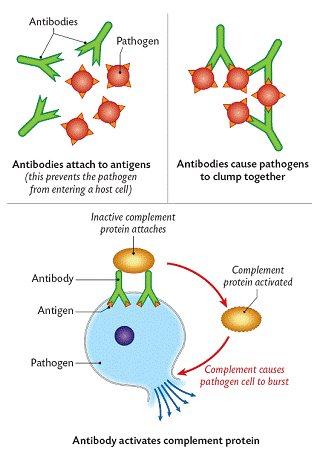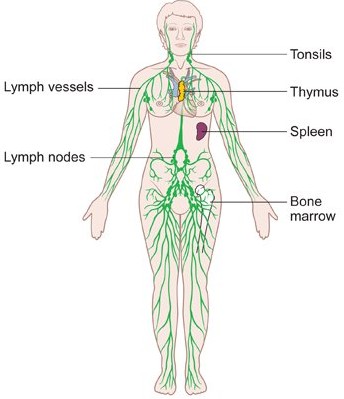Immune system
Immunity: the ability of the human body to protect itself against foreign antigens
Antigens: foreign, abnormal cells that can trigger an immune response in the body
Pathogens: bacterium, virus, or other microorganism that can cause disease.
Antibody: a protein produced by white blood cells that can neutralize a specific antigen
- Sometimes the body overreacts to certain foreign antigens, such as pollen, or certain foods which may result in allergy symptoms


The immune system can be broken down into two categories:
- Non-specific Immunity
- First line of defense
- Second line of defense
- Specific Immunity
- Third line of defense
- Natural Immunity
- Artificial immunity
- Third line of defense
1. Non-specific immunity:
- The human body’s ability to protect itself against a wide range of antigens
- Responsible for the first two lines of defense
a) First line of defense: The physical and chemical barriers
- Skin, mucous membranes and chemicals such as stomach acid and urine flow act as the first line of defense to defend the body from infection
b) Second line of defense: Internal defenses
- Phagocytes (cells that protect the body from ingesting harmful foreign particles. e.g. Macrophage, neutrophil) found in the bloodstream enter the lymphatic system to reach the site of the infection
- They move around in the interstitial fluid as needed, forming projections called pseudopods
- Once they reach the antigen, they surround and destroy the pseudopods, known as the process of phagocytosis
- Neutrophils, and natural killer cells also help to defend the second line of defense in the bloodstream
- Symptoms such as inflammation and an increase of temperature around the affected area may be resulted as our body attempts to increase the rate of metabolism to stop the infection
- In the case of infections that are not in the blood vessels, white blood cells can move to the outside of the capillaries
2. Specific immunity:
- The human body’s ability to protect itself against a specific antigen
c) Third line of defense: Adaptive immune response
- Lymphocytes containing T cells (thymus cells) and B cells (Bone marrow cells) eliminate antigen by releasing antibodies (B cell) and enzymes (T cells)
- Antibodies act in numerous ways:
- Bind to the antigens on the surface on the pathogens to prevent them from entering the host cell.
- Clump and engulf the pathogens all together
- Burst the pathogen

Acquisition of specific immunity
The body acquires specific immunity in two ways:
Natural immunity:
- Acquired following an infection
- The immune system has a “memory” of the antibodies produced by B cells to fight against the specific antigen causing the illness
- If the antigen enters the body again, long lived lymphocytes are able to quickly produce specific antibodies, and the patient will not develop the illness a second time
Artificial immunity:
- Obtained through the injection of a vaccine
- A vaccine contains dead or weakened antigens that can trigger the production and “memory” of antibodies without causing the illness
- In most cases immunity is permanent, in rare cases, boosters may be necessary to ensure maximum effectiveness of a specific immunity
The Lymphatic System
- An important part of the broader immune system
Over 60% of the human body is made up of water, with 7% of our body weight estimated to be blood. While 55% of blood consists of a fluid called plasma, and 90% of plasma is made up of water, we can deduce that only about 3.5% of the water content in our body is accounted by our bloodstream.
Where is the rest of the water content in the human body?
Body water is broken down into the following compartments:
Intracellular fluid: fluid contained within cells (67% of body water)
Extracellular fluid: fluid contained in areas outside of cells (33% of body water)
- Plasma (20% of extracellular fluid)
- Interstitial fluid (80% of extracellular fluid)
- Plasma that leaves the vessels and fills the space between the capillaries and the cells when blood reaches the capillary network
- Allows exchanges between the blood and the cells
- Lymph: the collected interstitial fluid in the lymphatic vessels
- Made up of mostly water


What is the lymphatic system?
- A circulation system that runs parallel to blood circulation
- Carries lymph through a network of vessels, organs and lymph nodes for filtration
- Collects excess interstitial fluid and returns it to blood circulation
- Water, proteins, and other substances leak out of capillaries into the surrounding body tissues, which may swell if not removed
- Transports fat from the digestive system to the circulatory system
- Produces immune cells such as antibodies and certain white blood cells that neutralize antigens

Lymphatic vessels:
- Similar to blood vessels and are located near them
- Carry lymph and return it to blood, collecting it after it exits the capillaries and emptying it into the two subclavian veins near the heart
- Lymph from the upper part of the body empties into the right subclavian vein
- Lymph from the rest of the body empties into the thoracic duct (collects lymph) and then to the left subclavian vein
- Lymph is circulated by the compression of the muscles on the vessels
Lymph nodes (lymph glands):
- Dispersed along the lymphatic vessels
- Filter lymph to identify and fight foreign particles and cancer cells
- Major site for lymphocytes, a sub-type white blood cell responsible for attacking foreign particles
- These bumps can be felt in the neck, armpits and groin (part of the body from the lower abdomen to the top of the inner leg)
- During an infection, lymph nodes swell and harden
Lymphatic organs:

- Function: White blood cell-filled organs that filter lymph and collect cellular debris, harmful bacteria and viruses
- Thymus: above the heart
- Where T cells are matured
- Bone marrow: in the centre of bones
- Generates pre-matured B cells
- Spleen: to the left of the stomach, below the diaphragm
- Synthesizes antibodies through lymph node circulation
- Tonsils: on the sides of the pharynx at the back of the mouth
- Lymph nodes that are responsible for protecting the body against respiratory and gastrointestinal infections.
- Tonsil infection: Tonsillitis
- Common childhood infection
- May be removed while other organs of the lymphatic system take over to protect the body
